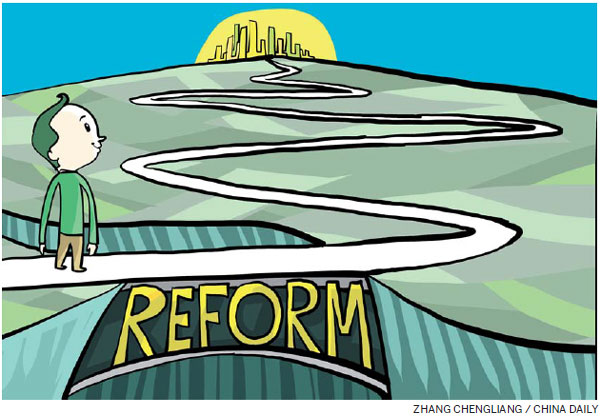Plan aims to balance growth with reform
Updated: 2015-11-04 08:28
By Louis Kuijs(China Daily)
|
||||||||


According to the communiqué issued after the recently concluded Fifth Plenum of the 18th Communist Party of China Central Committee, the 13th Five-Year Plan (2016-20) should help make China "moderately prosperous", with "medium to rapid" growth continuing, further reduction in poverty, and better social welfare, governance and environmental protection.
Growth ("development") remains the top priority with policymakers officially noting that 6.5 percent GDP growth from 2016 to 2020 will be enough to meet the existing target of doubling GDP between 2010 and 2020. This is a strong hint that the growth target for the 13th Five-Year Plan will be set at 6.5 percent.
Premier Li Keqiang basically confirmed this later on.
The emphasis on growth may possibly make it harder to make good progress with reforms. Economic growth depends strongly on the state of the global economy, and business confidence and organic growth in China. Thus achieving about 6.5 percent GDP growth in the next five years may require significant stimulus efforts. The problem is that if organic growth trends are weak, insisting on meeting previously set growth targets detracts attention from reform and reduces the appetite for reining in credit growth and reducing excess capacity.
In any case, to meet such growth targets the leadership emphasizes measures to upgrade the industrial structure such as boosting innovation, research and development and the Internet. The outline calls for deepening of State-owned enterprises-related, fiscal and financial reforms as well as further price liberalization.
The communiqué says that rebalancing the pattern of growth toward more consumption should be supported by policies to increase employment and wage growth, expand public services and further develop the services sector. The 12th Five-Year Plan (2011-15) period has already seen a rise in the share of consumption and services. However, there is still a long way to go.
Other key reforms needed to support rebalancing include reforming SOEs, especially leveling the playing field between SOEs and other companies; improving the allocation of capital and hardening budget constraints, especially on indebted heavy industry companies; reforming the hukou (household registration) system; and granting migrant workers greater access to public services in the cities where they work.
There is a welcome focus on social welfare, poverty reduction and equality, with the central government shouldering more responsibility for public service provision. The communiqué calls for pulling the remaining 70 million poor people above China's poverty line. It plans to offer free education up to the high school level to children from poor families and improve the social safety net. And it calls for universal coverage for a pension and serious illness insurance by 2020, and national pooling for basic pension, financed by the transfer of State-owned capital to the national social security fund.
For the first time, "green development" is a priority of a five-year plan. The leadership proposes continued cuts in the emission of carbon dioxide per unit of GDP and a rise in the share of non-fossil fuels. In line with the higher priority of environmental issues, there are signs that, having to date relied on targets in terms of intensity, China is ready to move to place absolute caps on emission and energy consumption. If confirmed, that would be a breakthrough.
The call for further opening-up and "going global" will be supported by a switch to a negative list for foreign direct investment, further opening-up of the service sector, the Belt and Road Initiative as well as more pro-active participation in international cooperation and global economic governance.
China has ended the one-child policy - all couples can now have two children. This will raise the number of births in the coming decades. However, the experience with partial relaxation in recent years suggests that the impact would be modest. Indeed, fertility rates in neighboring countries are not much higher than in China.
Overall, the summary of the leadership's proposal for the 13th Five-Year Plan suggests that it will build on the 12th Five-Year Plan in supporting rebalancing of China's economic growth and upgrading of the industrial structure. Implementation will be key, especially in areas such as State-owned enterprises reform and changing intergovernmental relations where progress is hard to achieve.
The author is head of Asia economics at Oxford Economics.
- Global health entering new era: WHO chief
- Brazil's planning minister steps aside after recordings revelation
- Vietnam, US adopt joint statement on advancing comprehensive partnership
- European border closures 'inhumane': UN refugee agency
- Japan's foreign minister calls A-bombings extremely regrettable
- Fukushima impact unprecedented for oceans: US expert

 Stars of Lijiang River: Elderly brothers with white beards
Stars of Lijiang River: Elderly brothers with white beards
 Wealthy Chinese children paying money to learn British manners
Wealthy Chinese children paying money to learn British manners
 Military-style wedding: Fighter jets, grooms in dashing uniforms
Military-style wedding: Fighter jets, grooms in dashing uniforms
 Striking photos around the world: May 16 - May 22
Striking photos around the world: May 16 - May 22
 Robots help elderly in nursing home in east China
Robots help elderly in nursing home in east China
 Hanging in the air: Chongqing holds rescue drill
Hanging in the air: Chongqing holds rescue drill
 2.1-ton tofu finishes in two hours in central China
2.1-ton tofu finishes in two hours in central China
 Six things you may not know about Grain Buds
Six things you may not know about Grain Buds
Most Viewed
Editor's Picks

|

|

|

|

|

|
Today's Top News
Liang avoids jail in shooting death
China's finance minister addresses ratings downgrade
Duke alumni visit Chinese Embassy
Marriott unlikely to top Anbang offer for Starwood: Observers
Chinese biopharma debuts on Nasdaq
What ends Jeb Bush's White House hopes
Investigation for Nicolas's campaign
Will US-ASEAN meeting be good for region?
US Weekly

|

|









